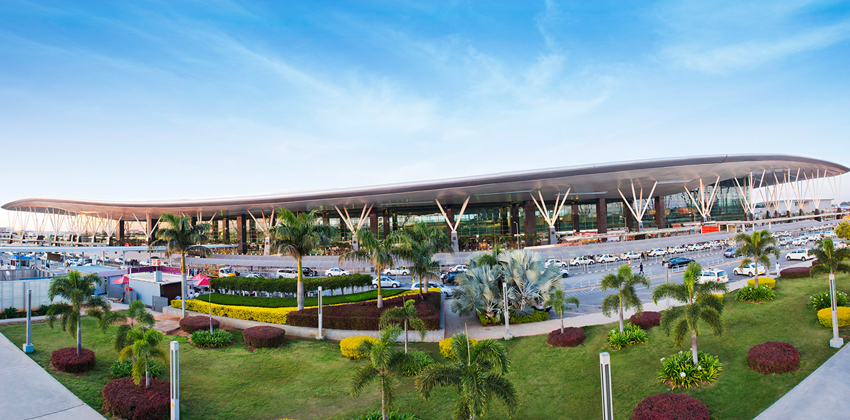Bengaluru airport becomes “contactless” zone, right from parking to boarding

‘Contactless’ would be the buzzword at the Kempegowda International Airport, Bengaluru, when operations resume from May 25.
In an effort to protect passengers and staff from the risk of COVID-19 transmission, Bangalore International Airport Limited (BIAL) has introduced a parking-to-boarding contactless journey at the airport.
With greater emphasis on minimum touch and minimum exposure between passengers and airport personnel, BIAL aims to minimise all physical contact at the airport. The technology will continue to enable a seamless airport journey, with greater emphasis on health and safety.
“We have introduced innovative contactless procedures to minimise exposure at the airport. These enhancements demonstrate our continued commitment to keep our passengers safe in this environment. We believe our new measures will boost confidence among passengers,” said Hari Marar, MD & CEO, BIAL.
Pre-Entry Process
As part of the new procedures, a passenger must wear a face mask and carry an e-/ printed-boarding pass.
At the departure gates, the passenger will undergo thermal scan and must show that the Aarogya Setu app on the passengers mobile phone has the ‘you are safe’ message. CISF personnel will verify the boarding pass and government-issued photo ID using an electronic device or through a magnified glass screen.
The door mats will be soaked with bleach (Sodium Hypochlorite Solution) at the terminal entrance to disinfect the shoes.
Staff attending to passengers with special needs like wheelchairs, as well as unaccompanied minors, will wear protective gear. Wheelchairs and baby strollers will be sanitised after every use. Trolleys will be sanitised after every use.
Check-in Process
Once inside the terminal, the passenger will scan the boarding pass at a contactless self-service kiosk, collect the baggage tag before proceeding to the airline counter to drop-off luggage. Passengers also have the option of using the assisted baggage drop counter to print and tag their baggage. Initially, a maximum of one hand baggage and one checked-in baggage will be allowed, as mandated by the Director General of Civil Aviation (DGCA).
At the airline bag drop counters, a transparent partition has been installed, to ensure the safety of both airline staff and passenger. In addition, the passenger will have to follow the safe distance markers placed on the floor. The passenger will scan the boarding pass on a sensor and show their ID and airline staff will accept the bags, ensuring at all times that the boarding pass does not touch the glass screen.
The automated bag drop facility will be available as applicable to the airlines. The passenger will be assisted by airport staff to avoid touching the machines themselves.
Security Check Process
At the pre-embarkation security check, the passenger will scan the boarding pass at a kiosk and put all belongings in the tray before going through the body scanner. Trays will be sanitised after every use.
Under the new contactless process, body scanning will be done using door frame metal detectors (DFMD). Stamping of the boarding pass has been suspended, as directed by the DGCA. Hand sanitisers will be available before and after security check.
Boarding Process
At the boarding gate, the airline staff will hand over a kit containing a face mask, face shield, and sanitiser to the passenger, who must put on the new mask and sanitise hands before boarding. The passenger will scan the boarding pass on the sensor. Airline staff will do temperature screening and then permit boarding.
Across the terminal bio-waste collection bins are placed so that passengers can dispose their used mask and other personal protective equipment.
Touch-free hand sanitisers have been placed across the Terminal for the safety of passengers.
Retail & Dining
Passengers can experience contactless dining and retail, with almost total elimination of human contact at outlets. They may reduce queueing time by pre-ordering F&B through their smartphones using the QR code displayed at the FSTR by BLR kiosks. The food can be delivered at the passenger’s place of choice within the Terminal. The payment would be made digitally at the time of ordering. For lounge access, passengers are advised to book their lounge lots online to avoid manual processing at the Terminal.
Parking
At parking zones, the ticket dispensing machine will print a ticket after recording the time and date of entry, thereby reducing human processing. At exit, the ticket will be scanned against a machine and the payment can be made digitally. Cash and card payment options, too, will be available, and be carried out with due precautions.
On Arrival
Passengers must follow the safe distance markers at the baggage collection area. Transit passengers will not be allowed out of the transit area.
Transport
At the taxi boarding area, fumigation will be done at regular intervals. Taxis will be sanitised and drivers screened before every trip. Masks are mandatory for drivers, as well as passengers. Passengers without masks will not be allowed to board a taxi.
As per a government of Karnataka, each taxi will accommodate only the driver + 2 passengers. BMTC buses will operate at 50 percent capacity.
Sanitisation and other measures
Apart from the contactless process, BIAL has also introduced a slew of other measures, including frequent sanitisation and disinfection of baggage and trollies, and fumigation of the terminal for safe travel. All touchpoints will be sanitised regularly at a predetermined schedule.
Repeated announcements will be made to maintain social distance and wear masks. Information related to social distancing and personal hygiene will be displayed on the Flight Information Display System (FIDS). Seating across Terminal, including at F&B outlets, has been rearranged and marked in a manner that promotes maintaining a safe distance.
The terminal will be well ventilated with minimum reliance on air-conditioning to avoid the spread of disease.




